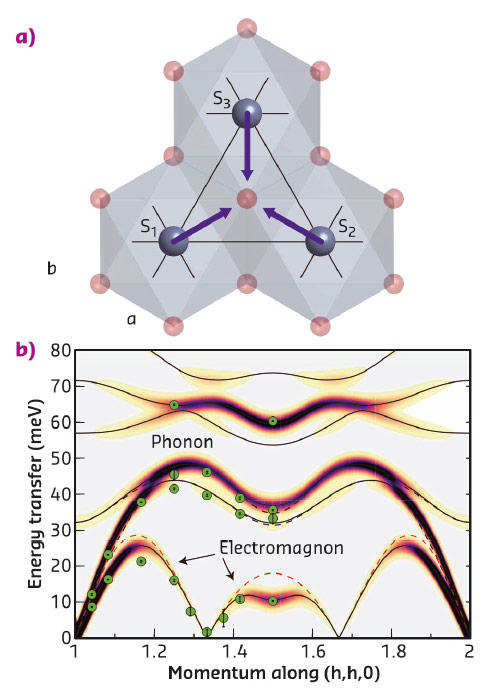- Home
- Users & Science
- Scientific Documentation
- ESRF Highlights
- ESRF Highlights 2016
- Electronic structure, magnetism and dynamics
- Probing magnetoelastic waves in quantum magnets
Probing magnetoelastic waves in quantum magnets
In general, lattice vibrations (phonons) in crystals interact weakly with the electronic degrees of freedom, such as charge and spin fluctuations. Here, an unexpectedly strong coupling between spin and lattice fluctuations has been discovered in a quantum magnet using inelastic X-ray scattering. In similar materials, non-resonant X-ray scattering can probe magnetism with high energy and momentum resolution.
Inelastic X-ray scattering (IXS) with meV energy resolution is an ideal tool to study lattice vibrations in crystals. IXS can also be sensitive to other degrees of freedom if strongly coupled to the phonons. One intriguing possibility is when polar phonons couple to spin waves in an ordered magnet. This creates electromagnons, quasiparticles that possess both magnetic and electric dipole moments [1]. Until the present discovery, direct observation of electromagnons was possible only via far-infrared light absorption. However, this technique is restricted to the measurement of spatially uniform changes (zero momentum) of the electric dipole moment due to the long wavelength of the resonant radiation. In this work, we show for the first time that strong magnon-phonon coupling enables the study of electromagnon dynamics with arbitrary momentum using IXS and we were able to directly probe their dispersion in LiCrO2.
LiCrO2 is a triangular lattice antiferromagnet of spin-3/2 chromium ions. It develops a three sublattice magnetic order at low temperatures where the angle between neighbouring spins is 120° (Figure 20a). A previous inelastic neutron scattering study on similar systems reported an anomalous “roton-like” dip in the spin wave dispersion that linear spin wave theory failed to adequately describe [2,3]. Previously reported large magnetostriction on similar Cr-Cr bonds suggested a phononic origin of this anomaly [4].
Using the high-resolution spectrometer ID28 designed for non-resonant inelastic X-ray scattering, we set out to look for anomalies in the phonon dispersion of LiCrO2 as it is cooled below the magnetic ordering temperature. Surprisingly, we found not only a change in the phonon energies but a completely new phonon mode appearing in the magnetically ordered phase without an accompanying structural phase transition. We could successfully reproduce this excitation theoretically after including a coupling between the spins and the lattice in our ab initio phonon model. Our analysis showed that the new mode is a special type of a magnetoelastic wave, an electromagnon. Beside the large magnetostriction, the key ingredient of the strong magnon-phonon mixing is the non-collinear magnetic order. This enables a linear coupling between magnons and phonons that is forbidden for simple antiferromagnets with collinear magnetic order. The measured dispersion of the electromagnon is shown in Figure 20b, together with the prediction of the coupled model. Our model not only reproduces the dip in the spin wave dispersion at (1.5,1.5,0) but also the inelastic X-ray scattering cross section.
 |
|
Fig. 20: a) Single triangular layer of Cr3+ ions (grey spheres) in LiCrO2 with magnetic moments (purple arrows) showing the 120° order. b) Green circles denote the phonon and electromagnon dispersion measured by IXS. Black lines show the coupled spin lattice model and dashed lines the non-interacting model. The colour map illustrates the calculated IXS intensities. |
This experiment presents a novel opportunity to study magnetoelastic waves via IXS with meV energy resolution. These excitations carry not only phononic character but also the quantum properties of the underlying magnetism, such as finite lifetime and energy renormalisation due to many body effects [5]. This makes IXS an exciting alternative to inelastic neutron scattering to study selected quantum magnets with high energy and momentum resolution on µm-sized samples.
Principal publication and authors
Electromagnon dispersion probed by inelastic X-ray scattering in LiCrO2, S. Tóth (a,b), B. Wehinger (a,c), K. Rolfs (d), T. Birol (e,f), U. Stuhr (a), H. Takatsu (g,h), K. Kimura (i), T. Kimura (i), H.M. Rønnow (b) and Ch. Rüegg (a,c), Nature Communications 7, 13547 (2016); doi: 10.1038/ncomms13547.
(a) Laboratory for Neutron Scattering and Imaging, Paul Scherrer Institute (Switzerland)
(b) Laboratory for Quantum Magnetism, EPFL (Switzerland)
(c) Department of Quantum Matter Physics, University of Geneva (Switzerland)
(d) Laboratory for Scientific Developments and Novel Materials, Paul Scherrer Institute (Switzerland)
(e) Department of Chemical Engineering and Materials Science, University of Minnesota (USA)
(f) Department of Physics and Astronomy, Rutgers University (USA)
(g) Department of Energy and Hydrocarbon Chemistry, Kyoto University (Japan)
(h) Department of Physics, Tokyo Metropolitan University (Japan)
(i) Division of Materials Physics, Osaka University (Japan)
References
[1] A. Pimenov et al., Nat. Phys. 2, 97 (2006).
[2] S. Toth et al., Phys. Rev. Lett. 109, 127203 (2012).
[3] M. Frontzek et al., Phys. Rev. B 84, 94448 (2011).
[4] A.B. Sushkov et al., Phys. Rev. Lett. 94, 137202 (2005).
[5] M.E. Zhitomirsky and A. L. Chernyshev, Rev. Mod. Phys. 85, 219 (2013).



